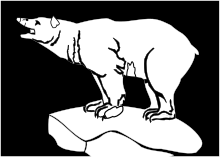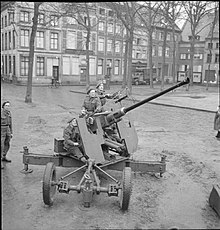The 92nd (Loyals) Light Anti-Aircraft Regiment was a mobile air defence unit of the British Army's Royal Artillery (RA) during World War II. The regiment had a special role on D-Day, and afterwards served throughout the campaign in North West Europe.

The Manx Regiment – the 15th Light Anti Aircraft Regiment, Royal Artillery – was raised in 1938 as a Territorial Army (TA) unit of the British Army. It recruited on the Isle of Man and formed part of Anti-Aircraft Command at the outbreak of World War II. The regiment was posted to the Middle East in November 1940, serving in the Western Desert, East Africa and Crete. In August 1942 it became the air defence regiment for the 7th Armoured Division. It served with the division through the North African, Italian and North West European campaigns. It was reformed in the postwar TA as 515 Light Anti-Aircraft Regiment before being reduced to a staff troop in 42nd (Lancashire) Division in 1955.

The 51st (Highland) Searchlight Regiment, Royal Artillery was a Scottish unit of Britain's Territorial Army (TA) formed for air defence just before World War II. It later served as an anti-aircraft (AA) artillery unit in the North West Europe Campaign 1944–45, and continued in the postwar TA into the 1950s.

The 114th Light Anti-Aircraft Regiment, was an air defence unit of the British Army's Royal Artillery during World War II. It landed on D-Day and saw action throughout the campaign in North West Europe, defending the vital port of Antwerp against Parachute mines and V-1 flying bombs.

The 73rd Light Anti-Aircraft Regiment, was an air defence unit of the British Army's Royal Artillery during World War II. It served during the London Blitz, landed on D-Day, seeing action throughout the campaign in North West Europe and defending the cities of Belgium against V-1 flying bombs.

The 120th Light Anti-Aircraft Regiment, was an air defence unit of the British Army's Royal Artillery during World War II. It landed on D-Day and saw action throughout the campaign in North West Europe, defending the vital Scheldt Estuary until the end of the war.
The 93rd Light Anti-Aircraft Regiment was an air defence unit of the British Army's Royal Artillery (RA) during World War II. Elements of the regiment landed with special equipment on D-Day, and served in the Normandy campaign. The regiment went on to defend Belgian cities against V-1 flying bombs and participated in the assault crossing of the Rhine.
2nd Anti-Aircraft Brigade was an air defence formation of the British Army during the Second World War, seeing active service in the Battle of France and the North African and Italian campaigns.

25th Light Anti-Aircraft Regiment, Royal Artillery was an air defence unit of Britain's Territorial Army (TA) formed in Liverpool just before the outbreak of World War II. It saw active service in the Western Desert Campaign, losing a battery at the Battle of Gazala, and then joined 50th (Northumbrian) Infantry Division for the assault landings in Sicily and Normandy. It ended the war with 53rd (Welsh) Infantry Division in Germany, and was reformed in the postwar TA, eventually merging with other Liverpool units.

The 94th Light Anti-Aircraft Regiment, Royal Artillery, was an air defence unit of the British Army during World War II. Initially raised as an infantry battalion of the King's Own Yorkshire Light Infantry in 1940, it transferred to the Royal Artillery in 1941. It served with Guards Armoured Division in Normandy and through the campaign in North West Europe until VE Day.

The 116th Light Anti-Aircraft Regiment was a Welsh mobile air defence unit of the British Army's Royal Artillery (RA) during World War II. It served with the 53rd (Welsh) Infantry Division in the campaign in North West Europe.

The 119th Light Anti-Aircraft Regiment, Royal Artillery, was an air defence unit of the British Army during World War II. Initially raised as an infantry battalion of the Queen's Own Royal West Kent Regiment (QORWK) in 1940, it transferred to the Royal Artillery in 1942. It served with 79th Armoured Division and then 15th (Scottish) Infantry Division, with which it fought in Normandy and through the campaign in North West Europe until VE Day.

The 103rd Light Anti-Aircraft Regiment, Royal Artillery, was an air defence unit of the British Army during World War II. Initially raised as an infantry battalion of the East Lancashire Regiment in 1940, it transferred to the Royal Artillery in 1941. It served in Northern England and Northern Ireland but saw no active service. Shortly before D Day, it was broken up to reinforce other units that fought in the campaign in North West Europe.

The 62nd Light Anti-Aircraft Regiment, Royal Artillery, was an air defence unit of the British Army during World War II. After serving with Anti-Aircraft Command during and after the Blitz, it trained to take part in the Allied invasion of Normandy. However, shortly before D Day, it was broken up to reinforce other units that fought in the ensuing campaign.

The 110th Light Anti-Aircraft Regiment, Royal Artillery, was an air defence unit of the British Army during World War II. Initially raised as an infantry battalion of the Dorsetshire Regiment in 1940, it transferred to the Royal Artillery in 1942. It served with 43rd (Wessex) Infantry Division in Normandy and through the campaign in North West Europe until VE Day.

The 40th Light Anti-Aircraft Regiment, Royal Artillery, was a Scottish air defence unit of Britain's Territorial Army (TA) during World War II. After serving with Anti-Aircraft Command in the defence of the UK, it joined 51st (Highland) Infantry Division and served with it at Alamein, in Tunisia and Sicily. It landed in Normandy on D + 1 and fought through the campaign in North West Europe, including the crossing of the Rhine, until VE Day. The regiment was reformed in the postwar TA but was amalgamated with other Scottish anti-aircraft units in 1950.

The 49th Light Anti-Aircraft Regiment was an air defence unit of Britain's Royal Artillery during World War II. After serving with Anti-Aircraft Command during and after the Blitz, it joined 78th 'Battleaxe' Division to take part in the Allied invasion of North Africa. It then served with the division in Sicily and Italy until it was disbanded at the end of 1944.

The 102nd Light Anti-Aircraft Regiment, Royal Artillery, was an air defence unit of the British Army during World War II. Initially raised as an infantry battalion of the Lincolnshire Regiment in 1940, it transferred to the Royal Artillery in 1941. It served with I Corps in the campaign in North West Europe, at times acting as infantry or administrative troops when the threat of air attack had diminished. It was disbanded after the war.

The 52nd Light Anti-Aircraft Regiment, was a Royal Artillery (RA) air defence unit of Britain's part-time Territorial Army (TA) converted from a field artillery unit just before the outbreak of World War II. It served in the Battle of France, shooting down a large number of aircraft before being evacuated from Dunkirk. It was then sent to the Mediterranean, where detached batteries were destroyed in the fighting in Greece and Crete. The reformed regiment then took part in the defence of the Suez Canal and later in the Italian Campaign. It continued in the postwar TA until 1955 when it merged with other units in Lancashire.

The 56th Light Anti-Aircraft Regiment, Royal Artillery, was a Royal Artillery (RA) air defence unit of Britain's part-time Territorial Army (TA) raised as a duplicate unit just before the outbreak of World War II. It served in the Norwegian Campaign and then joined 8th Armoured Division. It was sent to Egypt and participated in the Second Battle of El Alamein and the subsequent pursuit across North Africa. It then fought in the Italian Campaign, including defending the Salerno and Anzio beachheads. It often operated under US command, on one occasion in an anti-tank role. The regiment reformed as heavy AA artillery in the postwar TA and continued until 1955 when it merged with other units in Lancashire.







